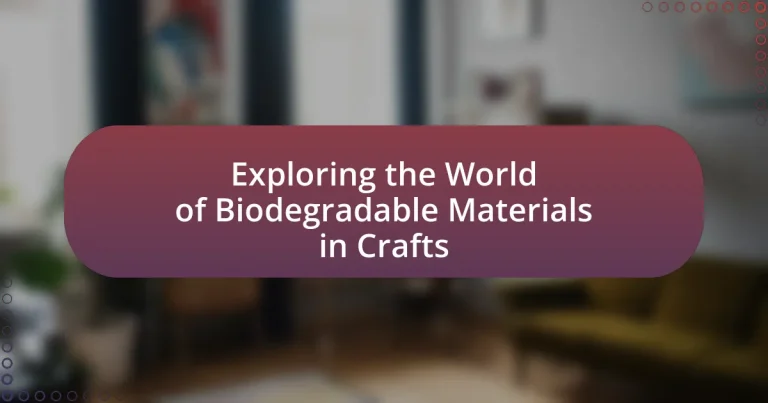Biodegradable materials in crafts are substances that decompose naturally through microorganisms, offering eco-friendly alternatives to traditional materials. This article explores the characteristics, benefits, and types of biodegradable materials commonly used in crafting, such as natural fibers, paper, and plant-based plastics. It highlights the importance of biodegradability in reducing environmental impact, promoting sustainability, and supporting a circular economy. Additionally, the article addresses challenges faced by crafters, misconceptions about biodegradability, and practical tips for effectively incorporating these materials into various projects.

What are Biodegradable Materials in Crafts?
Biodegradable materials in crafts are substances that can decompose naturally through the action of microorganisms, returning to the environment without causing pollution. Common examples include natural fibers like cotton, jute, and hemp, as well as plant-based materials such as paper, wood, and certain types of bioplastics. These materials are favored in crafting due to their eco-friendly properties, which align with sustainable practices and reduce environmental impact. The use of biodegradable materials in crafts supports waste reduction and promotes a circular economy, as they break down into non-toxic components over time, contributing to soil health and reducing landfill waste.
How do biodegradable materials differ from traditional materials?
Biodegradable materials differ from traditional materials primarily in their ability to decompose naturally through biological processes. Traditional materials, such as plastics and metals, can persist in the environment for hundreds of years without breaking down, contributing to pollution and waste accumulation. In contrast, biodegradable materials, like those made from plant-based sources or organic matter, are designed to break down into non-toxic components within a relatively short time frame, often within months to a few years, depending on environmental conditions. This decomposition process is facilitated by microorganisms, which convert these materials into natural substances like water, carbon dioxide, and biomass, thereby reducing environmental impact and promoting sustainability.
What are the key characteristics of biodegradable materials?
Biodegradable materials are substances that can be broken down by natural processes, primarily through the action of microorganisms. These materials typically possess characteristics such as being derived from natural sources, including plant or animal matter, which allows them to decompose efficiently in the environment. Additionally, biodegradable materials often have a defined degradation timeline, ranging from weeks to several months, depending on environmental conditions. For instance, studies show that materials like polylactic acid (PLA) can decompose within 90 to 180 days in industrial composting facilities. Furthermore, biodegradable materials generally produce less environmental pollution compared to non-biodegradable counterparts, as they do not contribute to long-term waste accumulation.
Why is biodegradability important in crafting?
Biodegradability is important in crafting because it reduces environmental impact by ensuring that materials decompose naturally, minimizing pollution and waste. When crafters use biodegradable materials, they contribute to sustainability by preventing long-lasting waste in landfills and ecosystems. For instance, according to a study published in the journal “Environmental Science & Technology,” biodegradable plastics can significantly reduce plastic pollution, as they break down into non-toxic components within a few months to a few years, unlike traditional plastics that can persist for centuries. This shift towards biodegradable options in crafting not only supports eco-friendly practices but also aligns with growing consumer demand for sustainable products.
What types of biodegradable materials are commonly used in crafts?
Commonly used biodegradable materials in crafts include paper, cardboard, natural fibers, wood, and plant-based plastics. Paper and cardboard are widely utilized due to their ease of manipulation and availability, making them ideal for various craft projects. Natural fibers such as cotton, jute, and hemp are favored for their durability and eco-friendliness, often used in textiles and weaving. Wood, sourced from sustainably managed forests, serves as a versatile medium for crafting items like toys and decorations. Additionally, plant-based plastics, derived from materials like cornstarch, are increasingly popular for creating biodegradable alternatives to traditional plastic in craft applications. These materials are recognized for their environmental benefits, as they decompose naturally, reducing waste and promoting sustainability in crafting practices.
What are the most popular natural fibers for crafting?
The most popular natural fibers for crafting include cotton, wool, linen, and jute. Cotton is widely used due to its softness and versatility, making it ideal for a variety of projects such as clothing and home textiles. Wool is favored for its warmth and elasticity, commonly used in knitting and felting. Linen, derived from the flax plant, is known for its strength and breathability, often utilized in sewing and upholstery. Jute, a strong and coarse fiber, is popular for making bags and ropes. These fibers are favored in crafting due to their natural properties, sustainability, and ease of use.
How are plant-based plastics utilized in craft projects?
Plant-based plastics are utilized in craft projects primarily as sustainable alternatives to traditional plastics. These materials, derived from renewable resources such as corn starch or sugarcane, can be molded, shaped, and printed, making them suitable for various applications like 3D printing, jewelry making, and creating decorative items. For instance, a study published in the Journal of Cleaner Production highlights that using plant-based plastics in crafts reduces environmental impact by minimizing reliance on fossil fuels and decreasing plastic waste.
What are the environmental benefits of using biodegradable materials in crafts?
Using biodegradable materials in crafts significantly reduces environmental impact by minimizing waste and pollution. Biodegradable materials decompose naturally, unlike traditional plastics, which can take hundreds of years to break down, contributing to landfill overflow and environmental degradation. For instance, a study by the European Commission found that biodegradable plastics can reduce greenhouse gas emissions by up to 50% compared to conventional plastics. Additionally, these materials often come from renewable resources, promoting sustainable practices and reducing reliance on fossil fuels. This shift not only conserves natural resources but also supports a circular economy, where materials are reused and recycled, further benefiting the environment.
How do biodegradable materials reduce waste in landfills?
Biodegradable materials reduce waste in landfills by breaking down naturally through microbial processes, which minimizes the volume of waste that remains in landfills. Unlike conventional plastics, which can take hundreds of years to decompose, biodegradable materials typically decompose within months to a few years, significantly decreasing the amount of waste accumulating in landfills. For instance, studies show that biodegradable plastics can reduce landfill waste by up to 30% when properly composted, as they convert into organic matter that enriches the soil rather than contributing to long-term waste.
What impact do biodegradable materials have on ecosystems?
Biodegradable materials positively impact ecosystems by reducing pollution and promoting soil health. When these materials decompose, they break down into natural substances that enrich the soil, enhancing nutrient availability for plants. Studies indicate that biodegradable waste can improve soil structure and fertility, which supports diverse microbial communities essential for ecosystem balance. Additionally, the use of biodegradable materials decreases the accumulation of non-degradable waste in landfills, thereby mitigating harmful effects on wildlife and reducing greenhouse gas emissions associated with waste decomposition.

How can crafters incorporate biodegradable materials into their projects?
Crafters can incorporate biodegradable materials into their projects by selecting items such as natural fibers, recycled paper, and plant-based adhesives. For instance, using cotton, jute, or hemp for textiles ensures that the materials will decompose over time, reducing environmental impact. Additionally, crafters can utilize recycled paper for card-making or scrapbooking, which is often made from post-consumer waste and is biodegradable. Plant-based adhesives, like those derived from starch or natural resins, can replace synthetic glues, further enhancing the sustainability of the project. These choices not only promote eco-friendliness but also align with the growing trend towards sustainable crafting practices.
What techniques can be used to work with biodegradable materials?
Techniques to work with biodegradable materials include composting, molding, and blending. Composting allows for the natural breakdown of organic materials, turning them into nutrient-rich soil. Molding techniques, such as using biodegradable resins, enable the creation of various shapes and forms, suitable for crafts. Blending biodegradable materials with natural fibers enhances their properties, making them more versatile for different applications. These methods are supported by research indicating that biodegradable materials can effectively decompose under the right conditions, contributing to sustainable practices in crafting.
How can crafters prepare biodegradable materials for use?
Crafters can prepare biodegradable materials for use by first selecting suitable organic substances such as paper, cotton, or natural fibers. These materials should be cleaned and processed to remove any contaminants. For instance, paper can be shredded and soaked in water to create a pulp, while natural fibers can be spun into yarn. Additionally, crafters can incorporate natural binders like starch or gelatin to enhance the material’s integrity. This preparation method aligns with sustainable crafting practices, as biodegradable materials decompose naturally, reducing environmental impact.
What tools are best suited for crafting with biodegradable materials?
The best tools for crafting with biodegradable materials include scissors, craft knives, biodegradable adhesives, and sewing tools. Scissors and craft knives are essential for cutting biodegradable materials like paper, fabric, and plant fibers. Biodegradable adhesives, such as those made from natural substances, are crucial for assembling projects without introducing harmful chemicals. Sewing tools, including needles and thread made from organic fibers, are important for creating durable items from biodegradable textiles. These tools facilitate effective crafting while ensuring that the materials remain environmentally friendly and sustainable.
What are some creative project ideas using biodegradable materials?
Creative project ideas using biodegradable materials include making plantable seed paper, crafting biodegradable pots from newspaper or cardboard, creating natural dyes from fruits and vegetables, and designing eco-friendly packaging from corn starch or mushroom mycelium. Plantable seed paper allows users to grow flowers or herbs after use, promoting sustainability. Biodegradable pots made from newspaper or cardboard decompose in soil, enriching it while supporting plant growth. Natural dyes derived from fruits and vegetables provide a non-toxic coloring option for fabrics and crafts. Lastly, eco-friendly packaging made from corn starch or mushroom mycelium serves as a sustainable alternative to plastic, breaking down naturally without harming the environment.
How can biodegradable materials be used in home decor crafts?
Biodegradable materials can be used in home decor crafts by creating items such as planters, wall art, and decorative objects that decompose naturally over time. For instance, materials like bamboo, cork, and recycled paper can be shaped into unique designs, providing an eco-friendly alternative to traditional decor. Additionally, using biodegradable paints and adhesives enhances the sustainability of these crafts, ensuring that the entire product is environmentally friendly. Studies show that incorporating biodegradable materials in crafts not only reduces waste but also promotes a circular economy, as these materials can return to the earth without harming the environment.
What are some examples of biodegradable materials in jewelry making?
Biodegradable materials in jewelry making include wood, bamboo, cork, and natural fibers such as cotton and hemp. These materials decompose naturally over time, reducing environmental impact. For instance, wood and bamboo are renewable resources that can be sustainably sourced, while cork is harvested from the bark of cork oak trees without harming the tree itself. Natural fibers like cotton and hemp are also biodegradable and can be used in various jewelry designs, contributing to eco-friendly practices in the craft industry.

What challenges do crafters face when using biodegradable materials?
Crafters face several challenges when using biodegradable materials, primarily related to durability, availability, and processing. Biodegradable materials often lack the strength and longevity of traditional materials, which can limit their use in projects requiring durability. Additionally, the availability of high-quality biodegradable options can be inconsistent, making it difficult for crafters to source suitable materials. Processing biodegradable materials can also be challenging, as they may require specific handling techniques or conditions to maintain their integrity, which can complicate the crafting process.
What are the limitations of biodegradable materials in crafts?
Biodegradable materials in crafts have several limitations, including reduced durability, limited availability, and potential performance issues. These materials often degrade more quickly than traditional options, which can compromise the longevity of crafted items. For instance, products made from biodegradable plastics may lose structural integrity when exposed to moisture or heat, limiting their usability in various applications. Additionally, the sourcing of biodegradable materials can be inconsistent, leading to challenges in maintaining a steady supply for crafting purposes. Furthermore, some biodegradable materials may not perform as well as conventional materials in terms of aesthetics or functionality, which can deter crafters from using them.
How do environmental conditions affect the performance of biodegradable materials?
Environmental conditions significantly influence the performance of biodegradable materials by affecting their degradation rates and structural integrity. Factors such as temperature, humidity, and exposure to sunlight can accelerate or decelerate the breakdown process. For instance, higher temperatures and increased moisture levels typically enhance microbial activity, leading to faster degradation of materials like polylactic acid (PLA) and starch-based bioplastics. Research indicates that PLA degrades more rapidly in composting conditions, where temperatures can reach 60°C, compared to ambient conditions. Additionally, UV radiation can weaken the molecular structure of biodegradable plastics, reducing their mechanical properties and lifespan. Thus, understanding these environmental factors is crucial for optimizing the use of biodegradable materials in various applications, including crafts.
What are common misconceptions about biodegradable materials?
Common misconceptions about biodegradable materials include the belief that all biodegradable items decompose quickly and that they can break down in any environment. In reality, the decomposition rate of biodegradable materials varies significantly based on environmental conditions such as temperature, moisture, and microbial activity. For instance, items labeled as biodegradable may take months or even years to decompose in a landfill, where conditions are not conducive to breakdown. Additionally, some biodegradable materials require specific industrial composting facilities to decompose effectively, which are not available everywhere. This misunderstanding can lead to improper disposal practices and environmental harm, as consumers may assume that biodegradable products will not contribute to waste issues.
How can crafters overcome challenges when using biodegradable materials?
Crafters can overcome challenges when using biodegradable materials by selecting the right type of material for their specific project needs. For instance, understanding the properties of various biodegradable options, such as PLA (polylactic acid) or recycled paper, allows crafters to choose materials that offer the necessary durability and functionality. Additionally, implementing proper storage techniques, such as keeping materials in a cool, dry place, can prevent degradation before use. Research indicates that biodegradable materials can perform effectively when used within their optimal conditions, as highlighted in studies on material longevity and performance. By educating themselves on these aspects, crafters can effectively navigate the limitations of biodegradable materials and enhance their crafting experience.
What best practices should be followed for successful crafting with biodegradable materials?
Successful crafting with biodegradable materials requires selecting appropriate materials, ensuring proper storage, and utilizing suitable techniques. First, choose biodegradable materials such as organic cotton, bamboo, or recycled paper, which decompose naturally and reduce environmental impact. Second, store these materials in a cool, dry place to prevent degradation before use, as moisture and heat can compromise their integrity. Third, employ crafting techniques that minimize waste, such as upcycling or using templates to maximize material usage. These practices enhance the sustainability of crafting projects and align with eco-friendly principles.
How can crafters educate themselves about biodegradable materials?
Crafters can educate themselves about biodegradable materials by accessing online resources, attending workshops, and reading relevant literature. Online platforms such as educational websites and forums provide comprehensive information on the types and properties of biodegradable materials. Workshops often offer hands-on experience and expert guidance, enhancing understanding. Additionally, books and articles from credible sources, such as “Biodegradable Materials: A Review” published in the Journal of Polymers and the Environment, provide in-depth knowledge and research findings on biodegradable options available for crafting.
What resources are available for crafters interested in biodegradable materials?
Crafters interested in biodegradable materials can access a variety of resources, including online platforms, workshops, and specialized suppliers. Websites like Eco-Craft and Green Craft offer tutorials and materials specifically designed for eco-friendly crafting. Additionally, organizations such as the Biodegradable Products Institute provide guidelines and information on biodegradable materials. Workshops hosted by local craft stores or community centers often focus on sustainable crafting techniques, allowing crafters to learn hands-on. These resources collectively support the growing interest in environmentally friendly crafting practices.
Where can crafters find suppliers of biodegradable materials?
Crafters can find suppliers of biodegradable materials through online marketplaces, specialty craft stores, and eco-friendly product suppliers. Websites like Etsy and Amazon offer a variety of biodegradable crafting supplies, while local craft stores may carry specific brands focused on sustainable materials. Additionally, companies such as Eco-Products and Biome sell biodegradable options directly to consumers, ensuring access to a range of materials suitable for various crafting needs.
What online communities support crafting with biodegradable materials?
Online communities that support crafting with biodegradable materials include platforms like Reddit, specifically the subreddit r/ZeroWaste, which focuses on sustainable living and crafting. Additionally, Facebook groups such as “Eco-Friendly Crafts” and “Sustainable Crafting” provide spaces for sharing ideas and projects using biodegradable materials. These communities facilitate discussions, share resources, and promote eco-conscious crafting practices, reinforcing the importance of sustainability in the crafting world.
What are the future trends in biodegradable materials for crafts?
Future trends in biodegradable materials for crafts include the development of mycelium-based products, plant-based bioplastics, and innovations in natural fibers. Mycelium, derived from fungi, is gaining traction due to its rapid growth and ability to decompose, making it an eco-friendly alternative for various craft applications. Plant-based bioplastics, such as those made from cornstarch or sugarcane, are being increasingly utilized for their versatility and reduced environmental impact compared to traditional plastics. Additionally, advancements in natural fibers, like hemp and bamboo, are enhancing their usability in crafts, promoting sustainability while offering durability. These trends reflect a growing commitment to environmentally responsible crafting practices.
How is technology advancing the development of biodegradable materials?
Technology is advancing the development of biodegradable materials through innovations in biopolymer synthesis and processing techniques. Recent advancements include the use of biotechnology to create bioplastics from renewable resources, such as corn starch and sugarcane, which can decompose naturally. For instance, research published in the journal “Nature” by authors from the University of Cambridge highlights the development of polyhydroxyalkanoates (PHAs), a type of biopolymer that is produced by microbial fermentation and exhibits similar properties to conventional plastics while being fully biodegradable. Additionally, advancements in 3D printing technology allow for the creation of biodegradable objects with complex designs, further promoting the use of sustainable materials in crafts. These technological innovations not only enhance the performance and versatility of biodegradable materials but also contribute to reducing environmental pollution associated with traditional plastics.
What innovations are emerging in the crafting industry related to sustainability?
Innovations emerging in the crafting industry related to sustainability include the development of biodegradable materials, such as plant-based resins and recycled paper products. These materials are designed to reduce environmental impact by decomposing naturally, unlike traditional plastics. For instance, companies are now producing biodegradable glues and adhesives made from natural sources, which significantly lower the carbon footprint of crafting projects. Additionally, advancements in 3D printing technology are allowing artisans to create items using sustainable filaments derived from organic materials, further promoting eco-friendly practices in the industry.
What practical tips can help crafters successfully use biodegradable materials?
Crafters can successfully use biodegradable materials by selecting the right types, such as paper, natural fibers, and plant-based plastics, which decompose effectively. It is essential to ensure that these materials are sourced from reputable suppliers who provide information on their biodegradability and environmental impact. Additionally, crafters should consider the end-use of their projects; for instance, items intended for outdoor use should be treated with natural finishes to enhance durability while maintaining biodegradability. Proper storage of biodegradable materials in a cool, dry place prevents degradation before use. Finally, incorporating techniques like composting leftover scraps can further promote sustainability in crafting practices.





